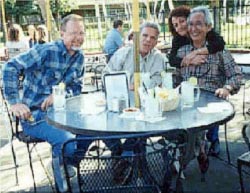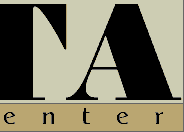GGAC Specialty, A Bonus

ime flies!
It was early February when Josh Popkin phoned me about translating for him arranging imports from Mr.N. Hirose in Japan. The answering machine message sounded like one of those rescue cases that I usually get from owners giving up their Akitas, and I did not know what it involved until I spoke to Josh. A previous translator had been used but a situation developed that made her services unavailable.
Now that all 4 Akitas arrived, I feel good about "rescuing" Josh from his predicament when he was unable to communicate properly with Mr.Hirose because of the language barriers. I understand Josh is now starting to learn Japanese conversation in preparation for his trip to Japan in the future.
Since February, for the past 2.5 months, a number of overseas calls have been made and faxes have been exchanged. Josh thought about going to Japan to pick up dogs and Mr.Hirose thought about coming to San Francisco himself with dogs.

The first of the 4 Akitas imported was a large red female named Hanna that Josh arranged to be bred to Mr. Hiroshi's Meiyosho male in Japan before being exported in whelp to America.
Three more Akitas would accompany Mr. Hirose to America. Kanzan, a top winner in JKC and AKIHO who has the "Meiyosho" title, Kou Unryu, a young promising two year old male who is being trained by Bill Bobrow, and
Ouka (for Loren & Cristina & Josh) a two year old brindle female personally selected by the Eglands as their Akita of choice (out of 250 entries) at the December, 1998 Akiho Headquarters show they attended in Japan.
Ouka’s previous owner took some convincing by Mr. Hirose to let her come to California, since Ouka was his only Akita! Everyone was pleased that Mr. Hirose brought a picture of Ouka's sire, and we were informed that he had won the "Taisho", Akiho’s highest award.
When both sides agreed to meet at San Francisco, they had decided to have me as translator, because I know the background of the arrangement and it is safer to have me than somebody hired locally. This is the way my "expense-paid trip" was arranged, and I left Toronto at 7:30 am on March 10th, Friday arriving San Francisco 10:30 am PST. Mr. Hirose arrived at 1:30 pm and Loren Egland came to greet him and carry us to his home.
By the time we claimed the three dogs at the cargo terminal, the rush-hour traffic had already started. As I sat in the comfortable passenger seat with Mr.Hirose while Loren was struggling through traffic jams, I had a brilliant idea of killing the time! I had the OneAkita brochure with pictures of 27 Akitas, and I asked Mr.Hirose to identify them in terms of Japanese, American, or percentage of blend. Loren warned me that it is not fair to "test" him without giving him the age/sex of the dogs, however, Mr.Hirose, as easy-going as he is, had "obediently" answered the questions. After all,he IS a life-time prominent Japanese Akita breeder, and he has nothing to fear! Out of 27 pictures, 17 of them he correctly identified without hesitation. 10 other ones, mostly blends, took longer for him to identify and although answers had not been 100% correct, it was just a matter of missing the exact ratio of blends in most cases.....50/50, 25/75, or 75/25 etc.
A traffic jam itself was nothing new to Mr.Hirose because it is worse in Japan. However, when Josh gave us rides to and from the show-site in his rented mini-van, Mr.Hirose looked slightly concerned. At the end of the weekend, when he was going back to SF Airport, he had a sigh of relief and said: "if Loren is taking me, I can go back to Japan in one piece" !!! Josh is obviously a "NewYorker" in his driving practice.
Despite the warning by Loren that it may rain, we had a wonderful Sunny California weather for the entire weekend, and the show site was very nicely set up. Mr.Hirose was so impressed about it and thought that it cost a lot and that the entry fee must be very expensive!!! When I told him that AKC entry fees are normally under $30, he could not believe it, and I know an Akiho entry is almost 3 times as much.
Before introducing Mr.Hirose to the exhibitors, he asked me to make sure that he was there as a breeder from Japan, and not representing JKC or Akiho this time. What he talks about is his own opinion based on his experience and observation. I found out that Mr.Hirose is not a typical Japanese tourist, and is neither shy nor snobbish. He is extremely easy to talk to and could have been left alone in the crowd when he does not speak a single word of English. I left him alone telling him to call me when the conversation gets beyond what he can manage with gestures and hand signals.
Mr.Hirose had thoroughly enjoyed spectating the show, and at one time, I had to warn him not to "double-handle" by giving verbal cheer to the dog he liked!!! The breed ring was the most exciting time for him, especially when the bitch he liked at the ringside was also the winner. He said "I was so happy to see her win and almost have tears in my eyes!!!" His constantly smiling face was decorated with tears in his eyes. It was such an emotional moment for him that the American judge selected the same dog as he would have selected if he were judging the same class. In the after show exchange of conversation with the judges, Mr. Hirose commented many times that it was "good choice" correct to Akita standard.
Compared to the time when he came to the St. Louis National as a member of the JKC delegation, Mr.Hirose felt more at home and also commented that in two years, the Akita type seems to have improved a lot. He liked the overall quality of Akitas at GGAC, but I told him it could be the regional variance between midwest and west coast. There were Japanese type blends and 100% Japanese lines Akitas represented at this show. Thus, the weekend of two Akita shows and two fantastic dinners (California Chinese buffet and California Mexican restaurant with Margarita jugs) was really enjoyed by Mr.Hirose, and also the complimentary BBQ offered by GGAC show committee is another good memory that he had asked me to send his heartful thank-you. The GGAC show catalog had an insert announcing Mr.Hirose's arrival at the show site and his willingness to answer any questions regarding Japanese Akitas as long as the questions are directed to him as a breeder/exhibitor and not as a JKC or Akiho rep. Some of his personal views are not always in complete harmony with these organizations present philosophy.
Mr.Hirose is 58 yrs old and he has been involved in Akitas/Shibas for close to 50 years. He is also a current VP of JKC's Akita section, but this title should not be counted , and what he talks about has nothing to do with official view by JKC or Akiho.
I must add that Mr. Hirose was very impressed by Loren’s kennel set-up and back yard that goes up toward the steep hill to the fence. He also felt so much at home there looking at Shadow (his favorite brindle, of such quality he thinks is hard to find even in Japan), Japan, Lion, and new imports Kanzan, Kou Unryu, and Ouka. He said he felt like he was living in Japan with all Akitas of Japanese type.
As is the custom in Japan, gifts were exchanged during the weekend. Mr. Hirose came with several gifts, including Japanese Akita calendars, Akita statues, and Japanese show collars and leads. One lead was specially made for "Mr. Loren" out of gold silk, but was lighter in weight and shorter than normal Akiho show leads so that it could be used for AKC style showing. Loren was heard bragging that this is the only lead in the world like it.
I am so happy to know everybody left San Francisco after the mission accomplished successfully. Translating Japanese/English is not something that can be done with mechanical accuracy. There is a subtle difference in their ways of expression in that English is verbal phonetic only language, and Japanese is situational language with complex idiomatic+ applied phonetics. Hidden implied portion has to be always added when translating Japanese into English, whereas vise versa is much straightforward. However, my experience of 48 hours of being a hired-translator made me aware that my Japanese vocabulary was not sufficient and some technical terminologies had to be explained to Mr.Hirose in layman's words. Japanese to English was much easier perhaps due to my 33 years in Canada in the latter half of my life.
Although I could not meet all the well known people and their Akitas at the GGAC show site due to the shortage of time, and I also missed watching most of the Akitas exhibited that I wanted to know more about, this was a bonus trip for me. Josh Popkin paid my airfare+telephone bills and Loren and Cristina Egland offered accommodation and fed us so nicely. It was such a memorable and educational weekend!
Mr.Hirose was asking me to pass his message to everybody in GGAC that he had enjoyed every minute of his stay in San Francisco and looking forward to meeting you again either in US or Japan...
Mitsko Suzaki
St.Catharines, Ontario
Canada
P.S. Both Mr.Hirose and Josh Popkin generously donated to Akita Watch rescue funds in lieu of my Translation service, which is greatly appreciated.





 ime flies!
ime flies!  The first of the 4 Akitas imported was a large red female named Hanna that Josh arranged to be bred to Mr. Hiroshi's Meiyosho male in Japan before being exported in whelp to America.
The first of the 4 Akitas imported was a large red female named Hanna that Josh arranged to be bred to Mr. Hiroshi's Meiyosho male in Japan before being exported in whelp to America.